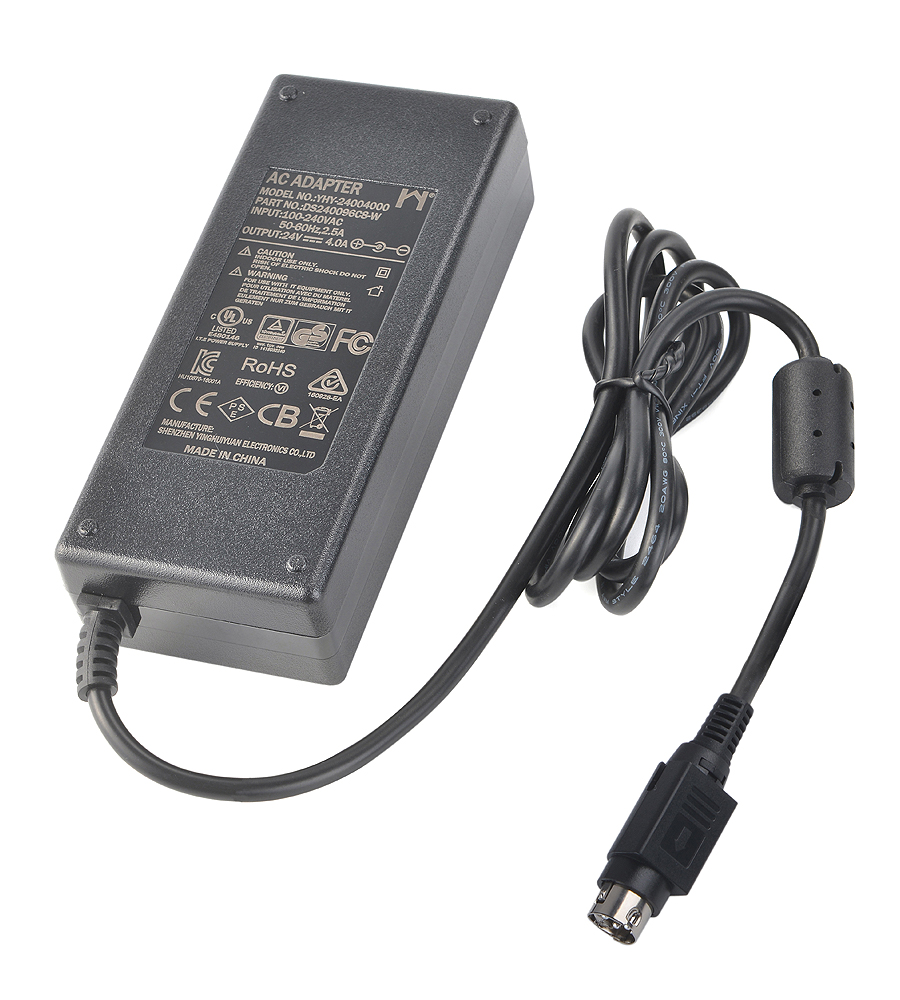Blog
Reliability Index of Power Adapter
Views : 1199
Update time : 2021-12-13 16:26:49
Reliability is a very important quality index of power supply adapter products. The quantification of reliability is helpful to put forward clear and unified indexes for the reliability of various products. The quantification of reliability can adopt different indexes according to needs.
Reliability indicators mainly include reliability, average life, failure rate and failure density.
1. Reliability: The reliability of the switching power supply adapter is the probability of normal operation, which refers to the probability of the switching power supply adapter completing the specified functions under the specified conditions and within the specified time. When calculating the reliability, the larger the number of products at the beginning of the test and the smaller the test interval, the higher the accuracy of the reliability.
When assessing the reliability of switching power supply adapters, the probability of failure or the probability of damage is also often expressed. The probability of failure is the probability of the corresponding event of reliability. Reliability and failure probability are very simple and intuitive to assess the reliability of components, switching power supplies, transformers, chargers or complex systems. The greater the reliability, the lower the probability of failure and the higher the reliability.
2. Average life: The average life of a switching power adapter refers to the average normal working time, which has different meanings for irreparable products and repairable products. For non-repairable products, the average life span refers to the average working time before the product fails, usually called MTTF, which is the average time before failure. For repairable products, the average life span refers to the average working time between two adjacent failures, that is, the mean time between failures, usually called MTBF, which is the average time between failures. The meanings of MTTF and MTBF are similar, and their mathematical expressions are also consistent.
3. Failure rate: The failure rate (failure rate, failure intensity) of a switching power supply adapter at any time is defined as: the probability of failure of the switching power supply adapter within a unit of time after working to t time. It can also be said that the failure rate is equal to the ratio of the number of product failures in a unit time after time t to the number of products still working at time t. The failure rate is often used to indicate the reliability index of electronic products and components. The lower the failure rate, the higher the reliability. The unit of failure rate is the percentage of time, such as %/h, %/kh, which represents the percentage of the number of failures of the tested product within 1 hour (or 1000 hours). Fit is commonly used abroad as the unit of failure rate, that is, 1 failure component occurs after 1 million components work for 1000 hours, which is called 1 fit.
4. Failure density: Product failure density (fault frequency) refers to the ratio of the number of failed products per unit time to the initial number (total) of the tested products. Products that fail during the test will not be replaced. The unit of failure density is 1/h, which is the ratio of the number of failed products per hour to the total number of tested products.
When evaluating the reliability of different products, one or two of the above four indicators of reliability can be selected. Which indicator is used depends on the convenience of use. For general switching power adapters, electronic equipment or systems, reliability (probability of failure) can be used; for complex electronic equipment or systems, average life can be used, because it is impossible for such products to be tested in large quantities; for components The failure rate obtained through a large number of test statistics is used to characterize the reliability; for the equipment that is one-time use or that fails to be repaired, the failure density is used to characterize its reliability.
The reliability of power adapter products can be quantitatively evaluated with mean time between failures (MTBF). At present, the electronics industry at home and abroad has taken the mean time between failures as one of the main standards for evaluating and measuring product quality. The mean time between failures of the complete civil electronic machine usually refers to the average working time from the time the product leaves the factory to the first failure; the mean time between the entire industrial electronic machine product, usually refers to the average time between two failures operating hours.
To improve the reliability and mean time between failures of switching power supply adapters, the most basic factors that affect the mean time between failures should be determined first, and then be resolved according to their causes. Most of the failures of switching power supply products are caused by damage to the components. The average trouble-free working time of an electronic component is its life cycle. Once an electronic component fails, it marks the end of the life of the power adapter. The more the number of components used in the switching power supply machine, the higher the failure rate, the lower the reliability, and the shorter the average trouble-free working time. Therefore, when designing the switching power supply, try to use integrated components to reduce the number of components in the complete machine and simplify the circuit structure. At the same time, components with low failure rates should be selected as much as possible, and components that meet national quality standards should be selected. In the stage of developing switching power supply adapters, self-made or non-standard components should be avoided as much as possible. In addition to the components, the failure of the solder joints is another important factor that causes the failure of the switching power supply product. Because mistakes are unavoidable in the process of printed circuit board production, assembly and soldering, if the number of solder joints in the product is large, the soldering technology or the quality of the flux is poor, the mean time between failures of the power adapter is bound to be become shorter.

Reliability indicators mainly include reliability, average life, failure rate and failure density.
1. Reliability: The reliability of the switching power supply adapter is the probability of normal operation, which refers to the probability of the switching power supply adapter completing the specified functions under the specified conditions and within the specified time. When calculating the reliability, the larger the number of products at the beginning of the test and the smaller the test interval, the higher the accuracy of the reliability.
When assessing the reliability of switching power supply adapters, the probability of failure or the probability of damage is also often expressed. The probability of failure is the probability of the corresponding event of reliability. Reliability and failure probability are very simple and intuitive to assess the reliability of components, switching power supplies, transformers, chargers or complex systems. The greater the reliability, the lower the probability of failure and the higher the reliability.
2. Average life: The average life of a switching power adapter refers to the average normal working time, which has different meanings for irreparable products and repairable products. For non-repairable products, the average life span refers to the average working time before the product fails, usually called MTTF, which is the average time before failure. For repairable products, the average life span refers to the average working time between two adjacent failures, that is, the mean time between failures, usually called MTBF, which is the average time between failures. The meanings of MTTF and MTBF are similar, and their mathematical expressions are also consistent.
3. Failure rate: The failure rate (failure rate, failure intensity) of a switching power supply adapter at any time is defined as: the probability of failure of the switching power supply adapter within a unit of time after working to t time. It can also be said that the failure rate is equal to the ratio of the number of product failures in a unit time after time t to the number of products still working at time t. The failure rate is often used to indicate the reliability index of electronic products and components. The lower the failure rate, the higher the reliability. The unit of failure rate is the percentage of time, such as %/h, %/kh, which represents the percentage of the number of failures of the tested product within 1 hour (or 1000 hours). Fit is commonly used abroad as the unit of failure rate, that is, 1 failure component occurs after 1 million components work for 1000 hours, which is called 1 fit.
4. Failure density: Product failure density (fault frequency) refers to the ratio of the number of failed products per unit time to the initial number (total) of the tested products. Products that fail during the test will not be replaced. The unit of failure density is 1/h, which is the ratio of the number of failed products per hour to the total number of tested products.
When evaluating the reliability of different products, one or two of the above four indicators of reliability can be selected. Which indicator is used depends on the convenience of use. For general switching power adapters, electronic equipment or systems, reliability (probability of failure) can be used; for complex electronic equipment or systems, average life can be used, because it is impossible for such products to be tested in large quantities; for components The failure rate obtained through a large number of test statistics is used to characterize the reliability; for the equipment that is one-time use or that fails to be repaired, the failure density is used to characterize its reliability.
The reliability of power adapter products can be quantitatively evaluated with mean time between failures (MTBF). At present, the electronics industry at home and abroad has taken the mean time between failures as one of the main standards for evaluating and measuring product quality. The mean time between failures of the complete civil electronic machine usually refers to the average working time from the time the product leaves the factory to the first failure; the mean time between the entire industrial electronic machine product, usually refers to the average time between two failures operating hours.
To improve the reliability and mean time between failures of switching power supply adapters, the most basic factors that affect the mean time between failures should be determined first, and then be resolved according to their causes. Most of the failures of switching power supply products are caused by damage to the components. The average trouble-free working time of an electronic component is its life cycle. Once an electronic component fails, it marks the end of the life of the power adapter. The more the number of components used in the switching power supply machine, the higher the failure rate, the lower the reliability, and the shorter the average trouble-free working time. Therefore, when designing the switching power supply, try to use integrated components to reduce the number of components in the complete machine and simplify the circuit structure. At the same time, components with low failure rates should be selected as much as possible, and components that meet national quality standards should be selected. In the stage of developing switching power supply adapters, self-made or non-standard components should be avoided as much as possible. In addition to the components, the failure of the solder joints is another important factor that causes the failure of the switching power supply product. Because mistakes are unavoidable in the process of printed circuit board production, assembly and soldering, if the number of solder joints in the product is large, the soldering technology or the quality of the flux is poor, the mean time between failures of the power adapter is bound to be become shorter.



